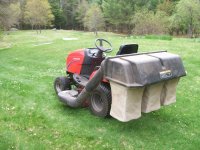That all depends a bit on the weather. If it is really wet, things can get soggy, and it then helps a lot to turn it, and get some air into it. The idea is to keep it hot inside so that it breaks down quickly. When I'm on the ball, I turn it every couple of weeks in the summer, and can have finished compost before the summer is over, our "summer" is three months, or so. In the fall when I'm getting ready to collect the leaves, I let the grass grow a bit longer so I get more "greens" in the mix. They have a higher nitrogen content, and heat things up quickly. I tend to get larger quantities of material at once, but not continually so that is why you see the three piles there. All are in different stages of decomposition. I have a small pile of very fine finished compost that I use around flowers, and small seeds, etc. This fall, I put the large pile that was left all on one garden. It wasn't quite finished, but I know that being tilled into the soil over the winter will fiinish the job, and it will be nice in the spring. It was steaming pretty good when I used the loader to move it to the garden. When I got the timing on turning right, and had some help from the winter, I've seen the piles steaming through the snow. It gets really cold here sometimes in the winter ( I've seen -35 degrees several times in my life) so the piles don't do much then, but you won't have that problem, and should be able to make compost year round. You can buy a compost thermometer with a long probe to monitor the interior temperature of the piles, but I never have.
If the piles don't seem to heat up at all (unlikely) they are probably too wet, too dry, or just don't have any "greens" at all in them. With a little trial, and error, you will figure it out quickly, and it will be great fun with your tractor! Higher, deeper piles work better than low, wide ones. That is one of the things that frequent turning helps with since things like leaves settle quickly, and get matted.
Chuck this a TERRIFIC description of the organic process for MT and anyone who's interested.
If I may, here a few more tips and observations from years of experimenting and doing this (the hard way, without a FEL... yet LOL):
1) Indeed, if you ever get too busy to touch that pile, no worries mate. Mother Nature (MN) is a master at doing the work all by herself. Depending on the location, temps, etc. within 8-12 months you will get a pile of black gold anyway under those few first inches. So what's to lose, right?
2) Don't put expensive herbicides or other poisons on those weeds, they make the best mulch! Why? Because among many other reasons all that vitality and strength they exhibit in taking over your yard and garden transforms into the best organic fertilizer! Just pull/cut and compost them before they ever start seeding (but that usually takes a good long while anyway.)
3) That pile can get really hot inside, up to 120-140 degrees.
4) Spring is a great time to start your piles but Fall is my favorite because if you mow this time of year, in many instances MN will have given you the IDEAL "premix" of leaves and green matter. Just dump from your bags or hopper into a great big pile and by March you'll have awesome black gold. Of course, as Chuck mentioned if you have a loader you can speed up the process greatly at ANY time of the year.
5) Spread 2-4 inches of finished compost or 3-6 inches of partially done compost around fragile plants, trees, etc. by the end of November. This will beat any of that expensive "mulch" by a mile in terms of both protection against frost and preparation for the following Spring.
6) Veggies, trees and flowers grown with lots of compost are FAR more disease-resistant than without (MN at work again!) I've observed that many, many times. They also give you the HUGE added benefit of knowing that you can pick anything and put it into your mouth or on the family table without worrying about the hundreds of toxic compounds which our food industry is not required to inform us about (unlike in most other "advanced" countries.)
7) Never worry about that clump of dirt that is around the root ball of any weed you pull. To the contrary, you want it in the pile, because it contains thousands of beneficial bacteria and micro-organisms that are essential in making and "balancing" your compost. Also, always sprinkle a few handfuls of already done compost over each cubic yard or so of new compost. They will eventually "seed" that new pile with "parent" beneficial bacteria and micro-organisms.
8) Likewise, put any new pile right next to the old one as thousands of earthworms will work their way into it once the heat has dialed down inside the pile ((look at Chuck's photos for a great illustration of this.)
9) I greatly increase yield AND save several hundred dollars for our family each year by making our own black gold.
Hope this helps.



